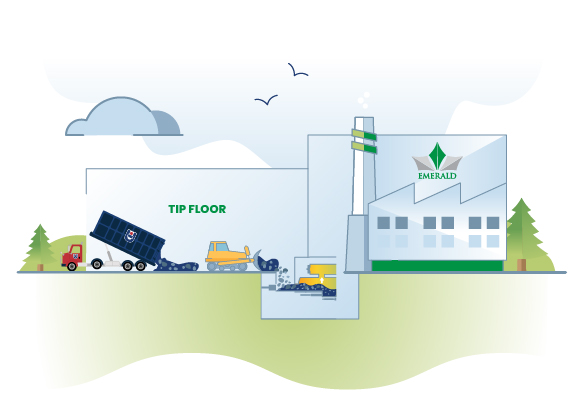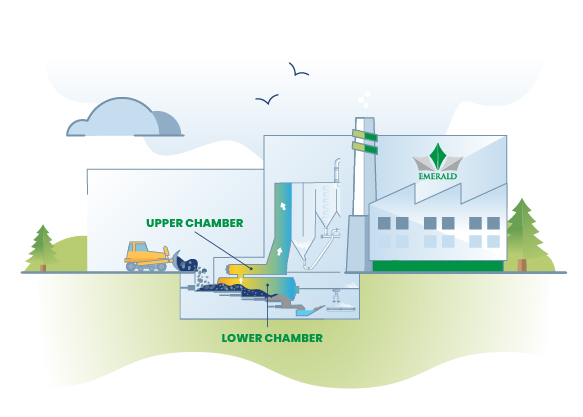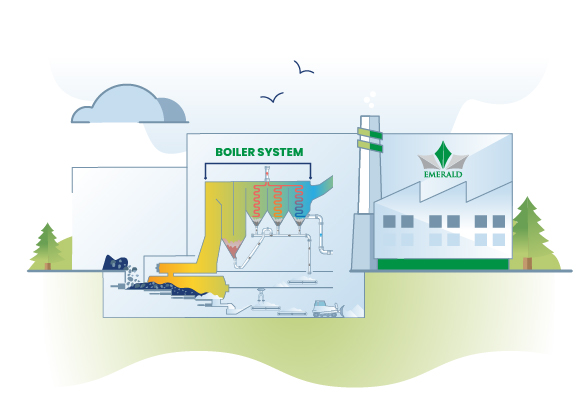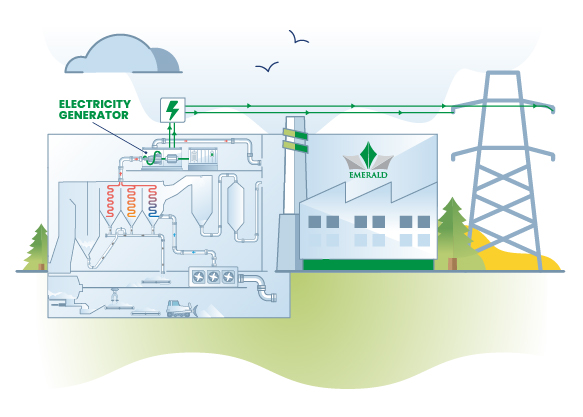Energy from Waste Process
How It Works: Science-Backed Energy from Waste Recovery
At Emerald Energy from Waste, we utilize a proven, scientifically engineered process to recover energy from Ontario’s non-hazardous solid waste safely. Each step maximizes energy output, minimizes environmental impact, and ensures full compliance with some of the world’s most stringent environmental regulations.
This isn’t guesswork; it’s decades of operational experience combined with advanced thermal recovery technology, and it’s effective. We are partnered with U-Pak Disposals to provide waste disposal services for the energy from waste process.
Energy from Waste Process: Step 1
Waste Delivery & Screening
All waste disposal arrives and deposits at our enclosed facility on the tipping floor. Here, our trained operators visually inspect and screen incoming material to eliminate any non-compliant or oversized items. This critical step helps ensure safe and efficient processing throughout the system.
-
- Tip floor storage capacity: 2,250 tonnes
- Equivalent to 4–5 days of operating feedstock
Only approved solid, non-hazardous waste moves on to the next stage.


Energy from Waste Process: Step 2
Thermal Processing with Gasification & Combustion
We utilize five Consumat gasifiers, each consisting of two chambers:
-
- In the Lower Chamber, waste is heated in a low-oxygen environment at 750–850°C for approximately six hours. This process converts the material into synthetic gas (“syn-gas”) rich in energy-bearing compounds.
- The syngas is then drawn into the Upper Chamber, where it fully combusts in an oxygen-rich environment at temperatures ranging from 1,000 to 1,100°C.
This dual-phase process ensures comprehensive thermal breakdown, with high-temperature residence times that meet or exceed regulatory standards for air emissions.
Design Capacity:
-
- 90–110 tonnes of waste per day
- Heating Value: 5,500 Btu/lb (12,764 kJ/kg)
- Combustion Residence Time: ≥1 second
Key Benefit: The intense heat not only generates usable energy but also destroys harmful compounds, thereby meeting strict emission thresholds.
Energy from Waste Process: Step 3
Heat Recovery via Boiler System
The hot flue gases produced during combustion pass through a water-tube boiler, where heat transfers to the water inside the tubes. This process generates high-pressure steam that drives electricity generation.
-
- Incoming gas temperature: ~1,000°C
- Outgoing gas temperature: ~230°C
- Steam output: 12,250 kg/hr
- Operating pressure: 600 psig (4,238 kPa)
- Steam temperature: 343°C (650°F)
Result: High-efficiency heat recovery with reduced residual gas temperatures and improved overall system performance.


Energy from Waste Process: Step 4
Electricity Generation
The steam turbine generator receives high-pressure steam, which generates electricity for both internal use and export to the grid.
-
- Turbine Model: Howden Twin CA510
- Rated Output: 9.0 MW
- Voltage: 4,160 VAC, 3-phase @ 60 Hz
Every tonne of waste diverted from landfills powers local communities, reducing greenhouse gas emissions and displacing fossil fuel-based energy sources. Visit our Energy from Waste Recovery page for more information on the benefits.
Energy from Waste Process: Step 1
Waste Delivery & Screening
All waste disposal arrives and deposits at our enclosed facility on the tipping floor. Here, our trained operators visually inspect and screen incoming material to eliminate any non-compliant or oversized items. This critical step helps ensure safe and efficient processing throughout the system.
-
- Tip floor storage capacity: 2,250 tonnes
- Equivalent to 4–5 days of operating feedstock
Only approved solid, non-hazardous waste moves on to the next stage.

Energy from Waste Process: Step 2
Thermal Processing with Gasification & Combustion
We utilize five Consumat gasifiers, each consisting of two chambers:
-
- In the Lower Chamber, waste is heated in a low-oxygen environment at 750–850°C for approximately six hours. This process converts the material into synthetic gas (“syn-gas”) rich in energy-bearing compounds.
- The syngas is then drawn into the Upper Chamber, where it fully combusts in an oxygen-rich environment at temperatures ranging from 1,000 to 1,100°C.
This dual-phase process ensures comprehensive thermal breakdown, with high-temperature residence times that meet or exceed regulatory standards for air emissions.
Design Capacity:
-
- 90–110 tonnes of waste per day
- Heating Value: 5,500 Btu/lb (12,764 kJ/kg)
- Combustion Residence Time: ≥1 second
Key Benefit: The intense heat not only generates usable energy but also destroys harmful compounds, thereby meeting strict emission thresholds.

Energy from Waste Process: Step 3
Heat Recovery via Boiler System
The hot flue gases produced during combustion pass through a water-tube boiler, where heat transfers to the water inside the tubes. This process generates high-pressure steam that drives electricity generation.
-
- Incoming gas temperature: ~1,000°C
- Outgoing gas temperature: ~230°C
- Steam output: 12,250 kg/hr
- Operating pressure: 600 psig (4,238 kPa)
- Steam temperature: 343°C (650°F)
Result: High-efficiency heat recovery with reduced residual gas temperatures and improved overall system performance.

Energy from Waste Process: Step 4
Electricity Generation
The steam turbine generator receives high-pressure steam, which generates electricity for both internal use and export to the grid.
-
- Turbine Model: Howden Twin CA510
- Rated Output: 9.0 MW
- Voltage: 4,160 VAC, 3-phase @ 60 Hz
Every tonne of waste diverted from landfills powers local communities, reducing greenhouse gas emissions and displacing fossil fuel-based energy sources. Visit our Energy from Waste Recovery page for more information on the benefits.

Why This Matters for Waste Disposal
Some individuals are skeptical about Energy from Waste, and understandably so. The crucial factor is not whether we incinerate waste but how we go about doing it.
Emerald Energy from Waste’s technology is for:
Complete combustion with advanced air quality controls
High energy efficiency with steam recovery and electricity generation
Rigorous environmental compliance backed by continuous monitoring
Proven results with over 3 million tonnes safely processed since 1992
This is not a landfill; it is modern, science-driven energy recovery designed for Ontario’s future.

Proven Climate Benefits
By diverting residual municipal waste from landfills and recovering energy, Emerald Energy from Waste reduces greenhouse gas emissions by approximately 908,000 tonnes of CO₂e annually, which is equivalent to removing nearly 200,000 cars from Ontario roads.
Emerald supports Ontario’s transition to a circular, low-carbon economy while reducing dependence on cross-border transport and distant landfill infrastructure.
Why Send It to Landfill When It Can Power the Grid?
Energy from Waste is not a theory. It is a proven technology that helps industrial, commercial, institutional, and municipal organizations manage residual waste responsibly and meet sustainability mandates.


